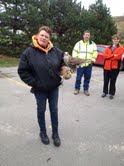Every fall, University of Rochester Recycling Coordinator Amy Kadrie organizes a trip to High Acres Landfill for the University community. I went on the trip this year and experiencing the waste management facility firsthand proved extremely interesting.
A few main points stuck out to me. The first was simply the amount of garbage we dispose of on a regular basis. Thirty five hundred tons of garbage is brought to High Acres daily. Although the site is extremely large, and the pits turn into grassy landfills once they have been filled, the amount of garbage we produce and how much space it takes up is pretty inconceivable in terms of the long-term health of our planet.
Another prominent theme throughout the tour was how economically viable the High Acres system is. Creating the landfill requires an incredible amount of money to function at every step – from lining the ground before the trash is put in, to condensing the waste matter with trucks, to draining the harmful gasses that seep out of the waste, to laying a final covering on top of the landfill. These features all cost millions of dollars. Unexpectedly, however, the landfill is also a tremendous source of revenue, by burning the gases extracted from the debris and selling the energy redeemed from it. This actually generates enough money for the landfill to make a profit. With both high costs and high profit margins, the disposal of our waste is a much more economically active system than I would have expected.
One positive concept is what happens once the landfill is complete. After the allotted amount of waste has been stored in the pit, the landfill is covered with multiple protective layers and lined with grass and vegetation. The community then collectively decides what they would like to do with the land. Additionally, High Acres has devoted a huge amount of their property to being a nature conservatory.
Our last stop on the tour brought us to a falconer. Since the odor from the garbage attracts hundreds of seagulls to flock over the area, the crew uses falcons, which prey on seagulls, to chase them away. The falcons do not actually kill the birds (for the most part), but the seagulls still fly away in fright and keep their distance from the landfill. This was a really interesting way of using a natural form of pest control.
If this tour sounds like something you might enjoy, keep your eyes out for Amy Kadrie’s spring tour of a Rochester recycling plant!
Written by Abigail Fagan, class of 2014


